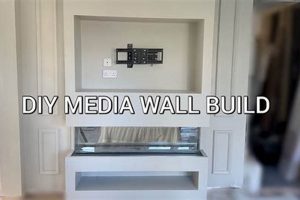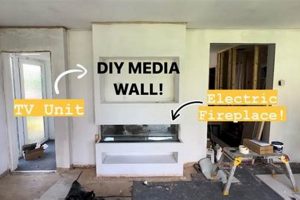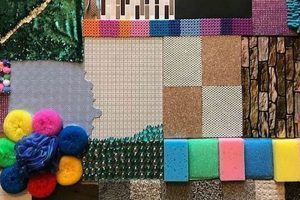A self-assembled construction toy-compatible vertical surface, frequently implemented within residential spaces, allows for customizable configurations of interlocking plastic bricks. Such installations provide a dedicated area for creative expression and construction activities, often utilizing adhesive or mechanical fasteners to secure baseplates to an existing wall structure. Examples include walls fully covered with baseplates or smaller, framed sections designed as focal points in a room.
The utilization of these surfaces can foster spatial reasoning skills and encourage imaginative play among children. Furthermore, it offers an engaging, interactive alternative to traditional art displays and provides a dynamic design element within a home environment. Historically, the concept evolved from simple table-top construction areas to more expansive, room-integrated features as building block toys gained popularity and versatile baseplates became readily available.
The following sections will explore various aspects, including materials, installation techniques, design considerations, and safety protocols, pertinent to the successful creation of such an interactive construction zone.
Tips for Constructing a Durable and Engaging Structure
Implementing a robust and aesthetically pleasing construction toy-compatible wall requires careful planning and execution. The following recommendations address key considerations for a successful project.
Tip 1: Baseplate Selection is Critical: Opt for high-quality baseplates from reputable manufacturers. Inferior materials may exhibit warping or diminished stud strength, impacting structural integrity and compatibility with construction toys.
Tip 2: Adhesion Method Dictates Longevity: When using adhesive, select a product specifically formulated for bonding plastics to the target wall surface. Thoroughly clean and prepare both surfaces prior to application to ensure optimal adhesion.
Tip 3: Mechanical Fasteners Enhance Stability: For larger installations or surfaces subject to frequent use, consider supplementing adhesive with mechanical fasteners, such as screws, to reinforce the bond and prevent detachment.
Tip 4: Precise Alignment is Essential: Prior to securing baseplates, employ levels and measuring tools to ensure accurate alignment. Misaligned baseplates can create visual inconsistencies and hinder the smooth connection of construction toys.
Tip 5: Consider Surface Preparation: Assess the wall’s existing surface. Repair any imperfections, such as cracks or peeling paint, prior to installation. Smooth, even surfaces promote optimal adhesion and prevent future issues.
Tip 6: Plan for Electrical Outlets and Obstructions: Account for the location of electrical outlets, light switches, and other wall-mounted fixtures during the design phase. Strategically position baseplates to avoid obstructing access or creating hazardous conditions.
Tip 7: Regular Maintenance Preserves Functionality: Periodically inspect the installation for loose baseplates or accumulated dust. Re-secure any loose components promptly and clean the surface with a soft cloth to maintain its appearance and functionality.
Following these guidelines ensures the creation of a resilient and visually appealing structure that provides a dedicated space for creative construction toy activities.
The subsequent sections will delve into design aesthetics and safety protocols for optimal integration into various living spaces.
1. Baseplate Material
The choice of baseplate material is fundamentally linked to the overall success and longevity of any self-assembled construction toy-compatible wall. The material directly influences the baseplate’s structural integrity, its ability to securely grip construction toy elements, and its resistance to wear and tear. Inferior materials may exhibit warping, reduced stud strength, or brittleness, leading to compromised stability and decreased play value. Conversely, utilizing appropriate materials such as acrylonitrile butadiene styrene (ABS) plastic, known for its durability and impact resistance, ensures a robust and reliable surface for construction activities.
Consider the example of a children’s museum employing construction toy walls as interactive exhibits. If low-grade polystyrene baseplates were used, the constant attachment and removal of building blocks would quickly degrade the stud connections, rendering the surface unusable. However, using ABS plastic baseplates, properly manufactured to precise tolerances, would withstand the rigors of public use, ensuring continued engagement and minimizing maintenance requirements. The material’s resistance to UV degradation is also significant, preventing discoloration and maintaining aesthetic appeal over extended periods.
In conclusion, selecting the appropriate baseplate material is a non-negotiable factor in creating a functional and durable construction toy wall. The material’s properties directly impact the user experience, the wall’s lifespan, and the overall value of the installation. Ignoring this critical element can lead to structural failures, safety concerns, and ultimately, a diminished return on investment. Thorough research and careful consideration of material specifications are essential for a successful outcome.
2. Adhesive Strength
Adhesive strength constitutes a critical determinant in the long-term performance and safety of a self-assembled construction toy-compatible wall. The efficacy of the bond between the baseplates and the underlying wall surface directly correlates with the structure’s ability to withstand shear, tensile, and compressive forces exerted during usage. Insufficient adhesive strength precipitates baseplate detachment, posing potential hazards, particularly in environments frequented by children. The selection of appropriate adhesive formulations, coupled with proper surface preparation, constitutes a primary consideration during the installation process.
An illustrative example underscores the practical significance of this relationship: A daycare facility constructs a construction toy wall utilizing an inadequate adhesive. Over time, the constant application and removal of building blocks subjects the baseplates to cyclical stress. The weak adhesive bond eventually fails, causing several baseplates to dislodge from the wall. This necessitates costly repairs and, more critically, presents a safety risk to the children using the facility. Conversely, a robust adhesive, specifically formulated for bonding plastics to painted drywall, would maintain structural integrity over extended periods, minimizing maintenance and ensuring a safer environment.
In summary, adhesive strength is not merely a tangential concern but a foundational element upon which the integrity and safety of a construction toy wall rests. Proper adhesive selection and application are indispensable for mitigating the risk of baseplate detachment, ensuring the structure’s longevity, and fostering a secure play environment. The absence of adequate adhesive strength directly undermines the intended functionality and introduces potential hazards, highlighting the imperative of prioritizing this aspect during project planning and execution.
3. Wall Surface Preparation
Wall surface preparation directly influences the adhesion and longevity of self-assembled construction toy-compatible walls. An unprepared surface can compromise the bond between the adhesive and the wall, leading to premature detachment of baseplates and potential structural failure. Contaminants such as dust, grease, or loose paint interfere with the adhesive’s ability to form a secure connection. The effect is cumulative; minor imperfections can propagate, weakening the overall integrity of the wall over time. A real-world example illustrates this: attempting to adhere baseplates directly to a wall with peeling wallpaper inevitably results in the wallpaper, along with the baseplates, separating from the underlying structure. This necessitates rework and highlights the importance of proper preparation.
Effective wall surface preparation typically involves cleaning the surface with a degreasing agent to remove contaminants, followed by sanding to create a slightly textured profile that promotes better adhesion. Applying a primer can further enhance adhesion, particularly on porous surfaces like drywall. The specific preparation techniques vary depending on the wall material and its condition. For instance, glossy surfaces require more aggressive sanding than matte surfaces. Similarly, previously painted walls may need to be inspected for lead-based paint, requiring specialized handling procedures to ensure safety. Failure to account for these variables can lead to suboptimal results and necessitate corrective action.
In summary, wall surface preparation is an indispensable component of successfully implementing a durable construction toy-compatible wall. Neglecting this crucial step undermines the adhesive bond, compromises structural integrity, and increases the likelihood of future maintenance issues. Proper preparation, tailored to the specific wall characteristics, is essential for achieving a long-lasting and safe installation, mitigating potential risks and ensuring a satisfactory outcome. The challenges lie in accurately assessing the wall’s condition and selecting appropriate preparation techniques.
4. Structural Support
Structural support forms a critical, often underestimated, element in the successful implementation of a self-assembled construction toy-compatible wall. The absence of adequate structural reinforcement can precipitate premature failure, resulting in detached baseplates and a compromised aesthetic. The connection is causal: insufficient support leads directly to instability, particularly under the repetitive stress of attaching and removing construction toy components. Proper structural design addresses the anticipated load, encompassing both the weight of the baseplates themselves and the applied forces from user interaction. The practical significance of this understanding is manifest in real-world scenarios; a construction toy wall installed in a high-traffic area, such as a children’s museum, demands a more robust structural framework than a similar installation in a low-use residential setting.
Practical applications of structural support principles manifest in several ways. For installations directly adhered to drywall, the use of appropriately sized and spaced construction adhesive is paramount. For larger or more demanding projects, mechanical fasteners, such as screws or bolts, anchored to wall studs offer enhanced stability. Furthermore, a backing board, such as plywood or medium-density fiberboard (MDF), can be secured to the wall and then faced with baseplates, distributing the load more evenly and minimizing stress on the underlying structure. Consideration should also be given to the type of construction toys used; larger, heavier models require more robust support than smaller, lighter ones. Regular inspection and maintenance of the structural components are essential to ensure long-term stability and prevent catastrophic failure.
In conclusion, structural support is not merely an ancillary consideration but an integral component of a functional and safe construction toy-compatible wall. A lack of adequate support mechanisms compromises the installation’s integrity, potentially leading to costly repairs and safety hazards. The challenges lie in accurately assessing the load requirements and selecting appropriate structural solutions. By prioritizing structural integrity during the design and installation phases, a durable and engaging construction toy environment can be achieved, providing years of creative interaction and enjoyment. The understanding of these structural principles directly translates into tangible benefits, including enhanced safety, extended lifespan, and improved overall performance.
5. Layout Design
Layout design, in the context of self-assembled construction toy-compatible walls, transcends mere aesthetic consideration; it directly influences functionality, accessibility, and long-term user engagement. A well-conceived layout optimizes the utilization of available space, facilitates intuitive interaction, and minimizes potential safety hazards. It dictates the organization of baseplates, the integration of structural elements, and the overall visual appeal of the installation.
- Spatial Optimization
Effective layout design maximizes the usable surface area of the construction toy wall. This entails strategic placement of baseplates to avoid wasted space and create a cohesive, continuous building surface. Inefficient layouts can result in fragmented areas that limit construction possibilities. Consider a narrow, vertical wall: a staggered arrangement of baseplates might prove more efficient than a strictly linear configuration, allowing for larger, more complex structures. The ultimate goal is to provide ample, accessible space for creative exploration.
- Ergonomic Accessibility
The layout must consider the physical capabilities of the intended users. For younger children, lower mounting heights and readily accessible baseplates are crucial. Conversely, for adult users, higher configurations might be preferable. Layout design should minimize the need for excessive reaching or bending, thereby promoting comfortable and sustained engagement. For example, incorporating a small step stool for younger users can significantly enhance their ability to access higher portions of the wall safely.
- Aesthetic Integration
The layout design directly contributes to the aesthetic integration of the construction toy wall within the surrounding environment. The arrangement of baseplates, their color scheme, and the overall visual pattern should complement the existing dcor. A well-designed layout transforms the wall from a mere functional element into an attractive design feature. Consideration should be given to symmetry, balance, and the use of negative space to create a visually appealing composition. For example, incorporating a frame around the construction area can provide a sense of structure and visual cohesion.
- Modular Flexibility
An adaptable layout design allows for future modifications and expansions. The use of modular baseplate arrangements enables users to reconfigure the wall to accommodate changing needs and preferences. This flexibility ensures that the construction toy wall remains engaging and relevant over time. The layout should facilitate easy addition or removal of baseplates without compromising the overall structural integrity. For example, using a grid-based system allows for seamless integration of new sections, providing a scalable and adaptable construction environment.
In summary, layout design represents a critical factor in the success of any construction toy-compatible wall. It encompasses spatial optimization, ergonomic accessibility, aesthetic integration, and modular flexibility. A thoughtfully designed layout maximizes usability, enhances visual appeal, and ensures long-term user engagement. By carefully considering these elements, a functional and aesthetically pleasing construction toy environment can be created, providing a platform for creative expression and interactive learning.
6. User Safety
User safety represents a paramount concern in the design and construction of any self-assembled construction toy-compatible wall. Neglecting safety protocols can result in physical harm, particularly for child users. The connection is direct: improper construction techniques or the use of substandard materials can lead to structural failures, creating hazardous conditions. Detached baseplates, sharp edges, or improperly secured components pose risks of cuts, abrasions, and impact injuries. Consider the scenario of a baseplate inadequately adhered to the wall, dislodging under pressure and falling onto a child. This event highlights the necessity of prioritizing safety in all phases of planning and execution. A comprehensive safety strategy encompasses material selection, installation methodology, and ongoing maintenance.
Practical safety measures include utilizing non-toxic adhesives and paints, especially crucial in environments frequented by young children who may be prone to mouthing objects. Baseplates should be securely fastened using both adhesive and mechanical fasteners where appropriate, mitigating the risk of detachment. Edge protectors or rounded corners can minimize the potential for cuts and scrapes. Regular inspections should be conducted to identify and rectify any loose or damaged components. Furthermore, providing clear instructions and guidelines for safe usage, particularly regarding weight limits and appropriate construction toy attachment techniques, contributes to a safer user experience. An illustrative example is the implementation of a maximum weight advisory for structures built on the wall, preventing overloading and potential collapse.
In summary, user safety is an indispensable consideration in the creation of a construction toy-compatible wall. Compromising safety can have severe consequences, ranging from minor injuries to more significant harm. The challenges lie in anticipating potential hazards and implementing proactive measures to mitigate those risks. By prioritizing safety throughout the design, construction, and maintenance phases, a secure and enjoyable construction toy environment can be fostered, promoting creative expression and interactive learning without compromising user well-being. The understanding of these safety principles directly translates into tangible benefits, including reduced liability, enhanced user satisfaction, and a commitment to responsible design practices.
Frequently Asked Questions
The following section addresses common inquiries regarding the planning, construction, and maintenance of self-assembled, construction toy-compatible walls.
Question 1: What types of adhesive are most suitable for adhering baseplates to a wall?
The selection of an appropriate adhesive is contingent upon the wall surface composition and the weight-bearing requirements of the installation. Construction adhesives specifically formulated for bonding plastics to drywall or painted surfaces are generally recommended. Prior to application, confirm compatibility with both the baseplate material and the wall surface. Consider also the adhesive’s volatile organic compound (VOC) content, particularly in environments sensitive to air quality.
Question 2: Is it necessary to use mechanical fasteners in addition to adhesive?
The necessity of mechanical fasteners depends on the scale of the installation and the anticipated load. For larger surfaces or those subjected to frequent use, supplementing adhesive with screws or bolts anchored to wall studs provides enhanced stability and prevents detachment. Mechanical fasteners are particularly advisable in environments where the wall is likely to experience significant stress or impact.
Question 3: How should wall surfaces be prepared prior to baseplate installation?
Proper wall surface preparation is critical for ensuring adequate adhesion. The surface should be thoroughly cleaned to remove dust, grease, and any loose debris. Repair any imperfections, such as cracks or peeling paint. Depending on the wall material, sanding may be necessary to create a slightly textured surface that promotes better bonding. Priming can further enhance adhesion, particularly on porous surfaces.
Question 4: What safety precautions should be taken during construction and use?
Safety protocols should include the use of non-toxic materials, particularly in environments frequented by children. Ensure proper ventilation during adhesive application. Edge protectors or rounded corners can minimize the risk of cuts and scrapes. Regularly inspect the installation for loose or damaged components. Implement weight restrictions for structures built on the wall to prevent overloading and potential collapse.
Question 5: How can baseplate alignment be ensured for a visually appealing result?
Precise baseplate alignment is essential for a cohesive and aesthetically pleasing outcome. Utilize levels, measuring tapes, and laser guides to ensure that baseplates are installed straight and evenly spaced. Careful planning and marking of the wall surface prior to adhesive application are crucial for achieving accurate alignment.
Question 6: What are the recommended maintenance procedures for a construction toy-compatible wall?
Routine maintenance involves periodic inspection for loose baseplates, which should be re-secured promptly. The surface should be cleaned regularly with a soft cloth to remove dust and maintain its appearance. Avoid using harsh chemicals or abrasive cleaners that could damage the baseplate material or adhesive bond.
In summary, a successful installation requires careful attention to adhesive selection, surface preparation, structural support, safety precautions, and alignment techniques. Consistent maintenance ensures long-term functionality and aesthetic appeal.
The subsequent section will address design considerations for integrating such installations into diverse living spaces.
Conclusion
This exploration has illuminated the multifaceted considerations involved in the creation of a “diy lego wall”. From material selection and structural integrity to user safety and aesthetic integration, the successful implementation demands a meticulous approach. The long-term viability and functionality are contingent upon adherence to established best practices, including proper surface preparation, appropriate adhesive selection, and the incorporation of mechanical fasteners where necessary.
The decision to undertake such a project should be informed by a thorough understanding of the inherent challenges and the potential benefits. As these installations become increasingly prevalent in residential and educational environments, a continued emphasis on safety and durability remains paramount. Further research into innovative materials and construction techniques may contribute to enhanced performance and wider adoption of this interactive and engaging design element.







